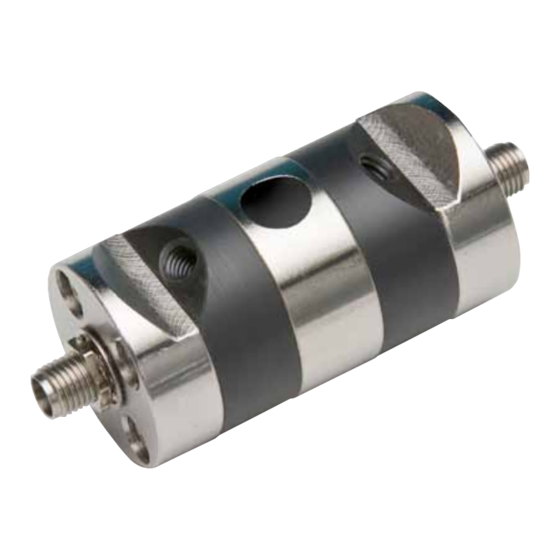Summary of Contents for WPI LWCC-M-10
- Page 1 WORLD PRECISION INSTRUMENTS Instrumenting scientific ideas INSTRUCTION MANUAL LWCC-M-xxx Measure low volume samples with UV/VIS absorbance spectroscopy Serial No._____________________ www.wpiinc.com 111717...
-
Page 3: Table Of Contents
Transmission Verification ......................4 Noise Determination ........................ 4 Refractive Index ......................... 4 Measuring in a Continuous Flow ................... 5 Measuring Discrete Samples with WPI’s Injection System ..........5 INSTRUMENT MAINTENANCE ...................... 6 Standard Cleaning ........................6 Advanced Cleaning ........................6 Storage ............................ - Page 4 World Precision Instruments...
-
Page 5: About This Manual
Fig. 1—The LWCC-M is available with 10, 50 and 100mm pathlengths. INTRODUCTION The Micro Liquid Waveguide Capillary Cell (WPI #LWCC-M-xxx) is a fiber optic, low volume flow cell for UV/VIS/NIR absorbance analysis; xxx represents the pathlength in mm. The LWCC-M is available with 10mm, 50mm and 100mm pathlengths. Based on WPI’s established liquid core waveguide technology, the analyte solution functions as... -
Page 6: General Warnings And Cautions
Concealed damage should be reported at once to the carrier and an inspection requested. Please read the section entitled “Claims and Returns” on page 13 of this manual. Please contact WPI Customer Service if any parts are missing at 941.371.1003 or customerservice@wpiinc.com. -
Page 7: Hardware Description
800827 Connector Fig. 2—LWCC-M-10 is shown. The LWCC-M-50 and LWCC-M-100 are longer. The LWCC-M (10, 50, 100mm) has SMA 905 terminated (WPI #FO-500-SMA1M) fiber optic connections. The light source and detector can be connected to the LWCC-M via two SMA- terminated fiber optic cables with a core diameter of 500µm. -
Page 8: Operating Instructions
Noise is determined using the ASTM E685-93 standard as reapproved in 2000. Use methanol as the solvent at a flow rate of 1.0mL/min. Using the WPI test setup, noise values are below 35µAU. See www.astm.org/Standards/E685.htm to obtain a copy of the standards document. -
Page 9: Measuring In A Continuous Flow
Observe the light intensity or absorbance baseline on the detector. Continue flushing until the signal is stable. See “Troubleshooting” on page 8 if the signal does not stabilize. Measuring Discrete Samples with WPI’s Injection System The sample measurement procedure can be improved... -
Page 10: Instrument Maintenance
If the UV readings are still low after cleaning, swab the fiber optic surfaces of the sample cell with a fiber optic Q-tip dipped in isopropyl alcohol. NOTE: The sample injector kit (WPI #58006) can be used to conveniently fill all LWCC-M models. Using the sample injector, the injection volume of the cleaning solutions per cycle can be reduced to the internal volume of the LWCC-M (for example, 0.26mL for... -
Page 11: Storage
LWCC-M Repeat steps 3–4 until a stable absorbance signal can be obtained. NOTE: For removal of persistent contamination, the 10% Contrad-NF solution can be heated to 60ºC prior to injection into the LWCC-M. Storage CAUTION: Do not leave the LWCC-M “half dried” and open to the air. Oxygen in the air may facilitate the growth of microorganisms inside the device. -
Page 12: Troubleshooting
Wipe all fiber optic end-faces, fiber optic cable end-faces with a connections on the LWCC-M using a fiber metal film generated during optic foam swab (WPI #800490) dipped in repeated connection methyl alcohol. attempts NOTE: Do NOT use cotton swabs (Q-Tips). -
Page 13: Additional Information On Contamination
UV range because of dust from the air or growth of microorganisms. • Some plastic tubing will release a substance that absorbs UV. In WPI’s lab, silicone tubing used in a peristaltic pump constantly released a contaminant even after a week of washing. -
Page 14: Specifications
* Reference: Two 600 µm fibers, butt-coupled ** Measured using ASTM E 685 - 93, includes intrinsic solvent absorbance WPI U.S. Patents: 5,444,807; 5,570,447; 5,604,587; 6,603,556; 6,385,380. Fig. 4—This graph show the percentage of light transmission at various wavelengths. The higher the light transmission percentage, the greater the resolution. -
Page 15: Index
WPI shall not be liable for any damage to data or property that may be caused directly or indirectly by use of this product. - Page 16 World Precision Instruments...
- Page 17 LWCC-M INDEX 15807 ......7 58006 ......2, 6 microorganisms .
- Page 18 World Precision Instruments...
- Page 19 LWCC-M World Precision Instruments...
- Page 20 International Trade Center, 175 Sarasota Center Blvd., Sarasota FL 34240-9258 Tel: 941-371-1003 • Fax: 941-377-5428 • E-mail: sales@wpiinc.com 1 Hunting Gate, Hitchin, Hertfordshire SG4 0TJ Tel: 44 (0)1462 424700 • Fax: 44 (0)1462 424701 • E-mail: wpiuk@wpi-europe.com Germany Zossener Str. 55, 10961 Berlin Tel: 030-6188845 •...















Need help?
Do you have a question about the LWCC-M-10 and is the answer not in the manual?
Questions and answers